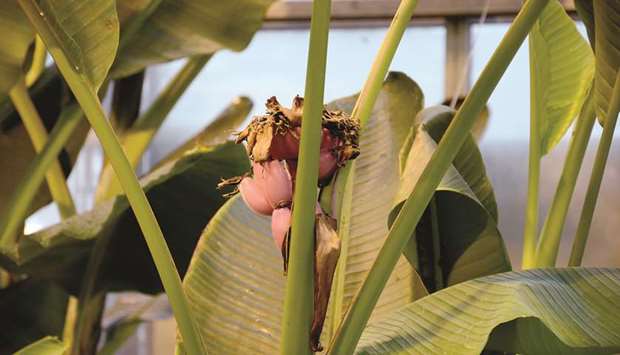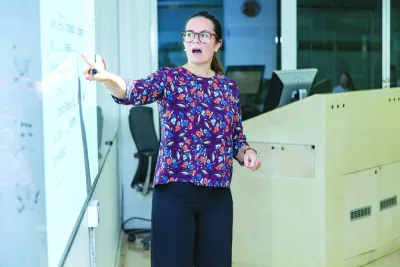A college town just outside of Brussels is an unlikely place to find banana plants – yet the University of Leuven hosts the world’s largest banana collection, with more than 1,500 different varieties.
Don’t expect banana plantations or tropical rainforests, though – the university’s greenhouse has only a few dozen fully developed banana trees. Their large leaves are often the size of people – or even bigger.
The collection itself is kept in more than 30,000 test tubes, where the plants are allowed to grow to about 10 to 15 centimetres.
Additionally, about 1,000 of the varieties have been backed up with a procedure called cryopreservation, in which the plant’s stem cells are frozen in liquid nitrogen and kept at minus 196 degrees Celsius.
“Who knows – if this collection had existed in the 1950s, maybe today we would be eating another type of banana, or several banana varieties,” says Rony Swennen, head of the university’s Laboratory of Tropical Crop Improvement.
“We think there’s only one dessert banana – but there are many.”
The collection has banana plants that can produce fruit with red skin and orange pulp, or fig-sized ones with a hard, purple-brown skin. There are cooking bananas, which are starchy and less sweet; bananas that are fermented; and dessert bananas, which are more sweet.
Wild bananas usually have large seeds and hardly any pulp, while cultivated ones have no seeds at all. “The banana is one of the oldest crops of humankind,” Swennen says.
In fact, human intervention has played a big role in maintaining today’s banana diversity – some varieties were being cultivated by humans as early as 7,000 years ago.
The bananas most suitable for eating are the seedless kind, which developed naturally. However, due to their lack of seeds, they couldn’t have survived if it hadn’t been for people propagating them by cutting off their side shoots.
“They are accidents, in fact – but because people liked them, they took them out of nature and grew them in their backyard,” says Bart Panis, who is responsible for the cryopreserved collection at the University of Leuven. “Without the human intervention, these would probably disappear.”
While bananas originate from South-East Asia, they made their way to Africa 3,000 to 6,000 years ago, where they became a staple food. Eventually, banana trees were also brought to the Americas.
Today, most of the bananas sold in North American and European markets originate from Latin America. The banana is a staple food for 400 million people and a total of 1 billion people consume it worldwide.
However, the diversity of bananas is not evident to most people living in developed countries, because more than 99 per cent of the banana market is dominated by one variety, the so-called Cavendish, a seedless dessert banana.
“The whole chain has been built around the Cavendish,” says Ines Van den Houwe, curator of the International Musa Germplasm Transit Centre, home to the world’s largest collection of banana germplasm.
Panis adds that the Cavendish is a very practical banana variety – it’s compact, so can be easily packed and shipped; it can be ripened artificially with ethylene, so it can be harvested green; and its sweet taste is beloved universally.
The variety entered into production in the late 1950s, after a previous variety grown for global export, the Gros Michel, was destroyed by the fungal disease Fusarium wilt – also known as Panama disease.
The Cavendish may now be facing a same fate as a strain of the Fusarium wilt disease has been damaging plants in parts of Asia and Mozambique. Many fear that it might spread globally and wipe out the Cavendish.
However, Swennen says there’s no reason to panic. “The banana is not under threat and the disease will not destroy the banana – it’s not true,” he says, noting that the disease could be managed through quarantines and preventative measures.
However, the threat does highlight the weakness of the global banana trade, which is built on mass producing a single variety of the fruit, instead of diversifying with different kinds of bananas that may be more resistant to disease and could better suit different ecologies.
“You have the collection, you have the diversity – use it,” Swennen says. “Whatever quality you want, we can give it to you.”
In fact, on many farms where bananas are not the only crops, the plant is the “backbone of the farming system,” Swennen says, because the trees provide shade.
“We know now that bananas and coffee are a perfect combination,” he notes. “You get a more aromatic coffee, a more high-quality coffee if it is grown in the shade of the banana, because coffee is a forest plant.”
Big banana companies have been seeking new alternatives to the Cavendish. However, testing new banana varieties can take years and there’s a risk that customers, who are used to one banana type, might not like the new product.
Xavier Roussel, vice president of marketing and sustainability at Dole, a major banana producer, says the company markets plantains, red bananas, baby bananas and manzanos in addition to the Cavendish variety.
“We have already successfully brought a number of alternatives to the Cavendish to the market and are continuously scouting new options,” he told DPA in an e-mail.
The collection at the University of Leuven is under the auspices of Food and Agriculture Organization of the United Nations (FAO) and is managed by Bioversity International, a non-profit international agricultural research organisation. – DPA

A wild banana variety known as Musa velutina, or the pink dwarf banana, grows at a greenhouse at the University of Leuven.


